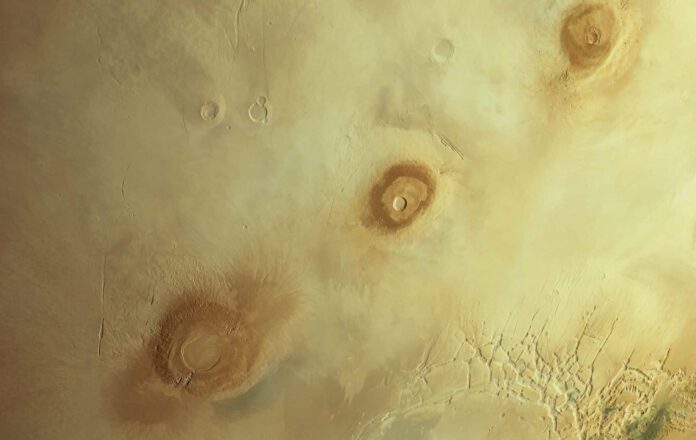
The Mars Odyssey
The Mars Express orbiter first commenced its journey to Mars in late 2003 and has been orbiting the red planet for nearly 21 years. During this period, it has completed an astounding 25,000 orbits around Mars. To commemorate this significant milestone, a stunning photograph of Mars has been taken by the orbiter.
Fascinating Martian features revealed
Visible in this mesmerizing picture is a large portion of the Martian surface, featuring some of the most famous volcanoes located on the planet. Most notably, Olympus Mons; not only is it the largest volcano on Mars, but it also holds the title as the biggest in our solar system! Olympus Mons stands nearly 22 kilometers tall and covers an area of about 300,000 square kilometers, making it seven times larger than certain European countries.
Major Volcanoes
Other than Olympus Mons, the picture exhibits other eminent volcanoes, like Ascraeus Mons, which is also among Mars’s largest with 18 kilometer in height. Also seen in the picture are Arsia Mons – slightly taller than Earth’s Mount Everest – and Pavonis Mons, standing approximately 14 kilometers tall.
Canyon System
Below this trio of volcanoes is Noctis Labyrinthus, a canyon system with valleys up to 30 kilometers wide and 6 kilometers deep. The canyon system spans about 1190 kilometers; which is approximately the distance covered when driving from northern to southern Europe 3.5 times.
Clouds
What strikes the eye are the blue shades interspersed with the otherwise sandy-colored picture, caused by clouds formations. At the bottom, Lee wave clouds are visible, which are formed when air currents encounter obstacles like mountains.
Phobos
If one looks closely, it’s not just Mars that has been immortalized by the Mars Express, but also its moon Phobos can be seen, slightly below Arsia Mons. Phobos is located relatively close to Mars, the distance between the two celestial bodies is just 6000 kilometers. For comparison, our moon orbits Earth from a distance of about 385,000 kilometers.
A Wealth of Work Achieved
This incredible photograph serves as the ESA’s celebration of the Mars Express’s 25,000th orbit around Mars. This impressive milestone was actually reached in October 2023, but it wasn’t until now that the European Space Agency elaborated on it. Not only with this picture, but by reflecting on the wealth of knowledge the Mars Express has already provided about the red planet. The orbiter has been able to map Mars’s atmosphere and provide significant insights into the planet’s water history. The two moons of Mars – Phobos and Deimos – have also been studied in unprecedented detail, and fantastic photographs of Mars have been captured.
The ESA plans to continue operations with the seasoned orbiter. In 2023 the Mars Express mission was extended for the umpteenth time, with plans to keep the orbiter circulating Mars until at least 2026. The information the space probe continues to gather is highly valued. Not only because it increases our understanding of Mars, but also because the data is vital for upcoming Mars missions. For example, the European Space Agency hopes to send a rover to Mars in the coming years to search for signs of past Martian life. Meanwhile NASA plans to retrieve samples collected by Mars rover Perseverance from Mars and bring it back to Earth. The more we learn about Mars, especially from orbiters like Mars Express, the higher the likelihood of success for ambitious future missions.











